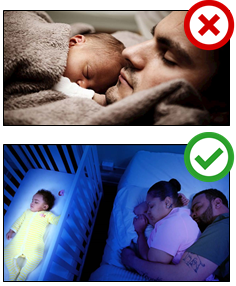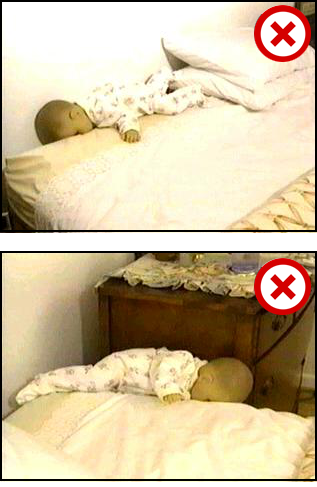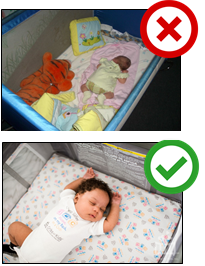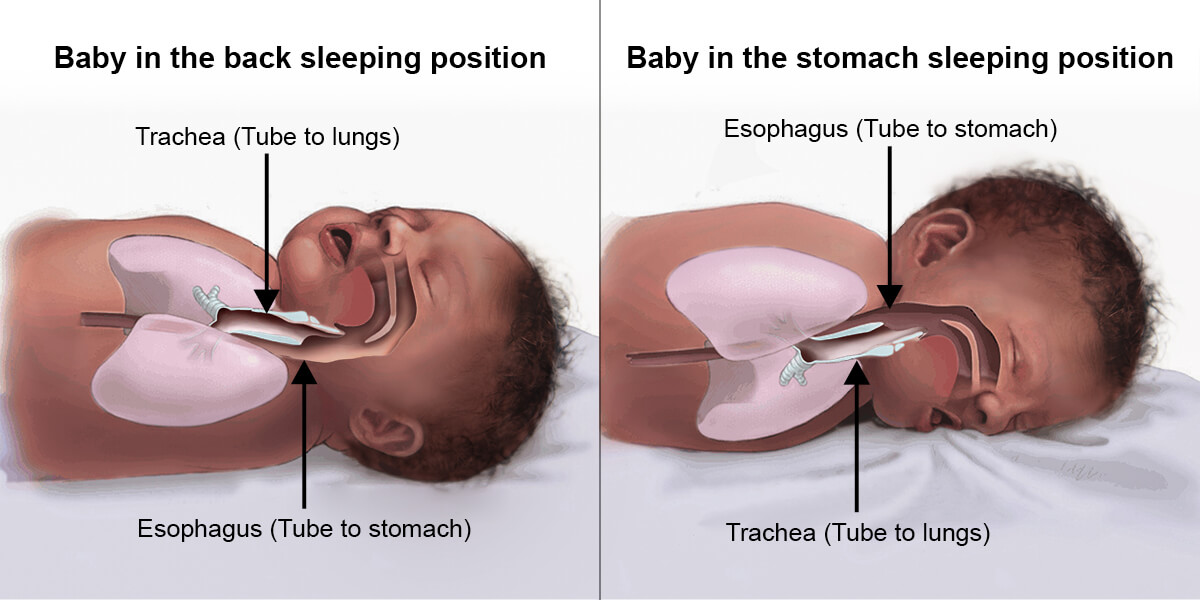Course Modules
Remembering safe sleep practices is as easy as ABC... Alone, Back, Crib
A STANDS FOR ALONE

Alone means that babies should be placed in their OWN safe sleep space, not to be shared with a caregiver, sibling, pet, etc.
This can be a confusing message and is not meant to be a term of neglect, or lack of attachment. Parents should not leave their infants alone in a different room to sleep, but bring baby into their room to sleep.
American Academy of Pediatrics recommends that babies sleep in the same room as their parents for at least the first six months of life. This makes routines easier for feeding, and convenient when baby needs attended to.
The top picture shows an unsafe sleeping environment - dad sleeping with the baby. Parents and caregivers can hold their babies while the baby is sleeping, but caregivers should NOT sleep while holding their babies.
It's extra important for caregivers to not bed share with baby if:
- They have been drinking alcohol, used marijuana or taken any medicines or illicit drugs. The risk of sleep-related infant death is more than 10 times higher for babies who bed share with someone who is fatigued or has taken medications that make it harder for them to wake up or has used substances such as alcohol or drugs.
- Their baby is very young, small or was born prematurely. The risk of sleep-related infant death while bed sharing is 5 to 10 times higher when a baby is younger than 4 months old. And the risk of sleep-related infant death is 2 to 5 times higher when babies are born preterm or with low birth weight.
The bottom picture represents the golden rule or phrase, share the room not the bed.
The safest place for baby to sleep is in the room where you sleep, but not in your bed.

Adult beds are dangerous for babies to sleep; there are many things that could happen:
- Baby could roll off the bed
- Baby could become trapped between bed and wall or bed and headboard
- Baby could suffocate due to soft surfaces, such as blankets, pillows, and thick mattresses
- Caregivers, siblings, or pets can roll onto baby causing suffocation
B STANDS FOR BACK
B stands for back – back is best. The safe sleep recommendations have changed over the years, but research has shown that placing a baby on their back to sleep makes it easier for them to breathe and they are less likely to choke.
You should place your baby to sleep on his/her back for their first year of life.
Why is the back position safer than the belly position?
Do I need to reposition my baby to their back every time they roll to their stomach?
If a baby can NOT consistently roll to their stomach ON THEIR OWN, then they should be repositioned on their back each time they end up on their stomach.
If baby can consistently roll to their stomach on their own, then they will not need to be repositioned each time because they have the muscle memory to move their head to the side or even the strength to roll back on to their back.
One thing you might be worried about with baby sleeping on their back is developing a flat spot of the back of their head. One way to avoid this, is practicing supervised tummy time. Place your baby on their tummy while awake and supervised for short periods of time beginning soon after hospital discharge. Tummy time should be increased incrementally to at least 15-30 minutes daily by 7 weeks of age.
C STANDS FOR EMPTY CRIB

C stands for an empty crib. Parents and caregivers should place their babies in a crib, portable crib, or bassinet whenever the baby is sleeping, for naps and at night time.
Overheating can increase the risk of SUID. A baby only needs one more layer than an adult would wear in the same environment to be comfortable. Discourage families from putting a hat on their baby while indoors once home from the hospital.
Empty cribs are best, it eliminates dangers related to suffocation – we would recommend only having a firm mattress and tightly-fitted sheet in the crib or safe sleep environment when baby is sleeping.
Please do not place use blankets, pillows, stuffed animals, etc. in the crib with baby. These are safety hazards for suffocation and strangulation.
The top picture has blankets, crib bumpers, stuffed animals, and the baby is placed on their stomach. You can spot multiple hazards in this picture compared to the bottom one where the baby is placed in an empty portable crib on their backs.
Babies do not know comfort until you introduce it to them. Unlike us, babies are perfectly content in what we would consider a boring or uncomfortable sleeping environment without blankets, pillows, mattress toppers, etc. What is comfortable for us could be dangerous for baby.
Sleep clothing, such as sleepers, sleep sacks, and wearable blankets are safer for baby than blankets. Dress the baby, not the bed!
Babies should sleep on firm, flat, and non-inclined surfaces. Any surface used for sleeping with an incline of more than 10 degrees, is unsafe.
Do not place weighted blankets, weighted sleepers, weighted swaddles, etc. should not be placed on or near your sleeping baby. These products increase the risk of suffocation and SIDS, and should not be encouraged for use.
Room Set Up
It is recommended to place the portable crib in parent’s room for at least the first six months of life, ideally for the first year.
The portable crib should be placed away from windows, drapes, curtains, corded blinds, electric cords, vents, radiators, and space heaters.
The temperature in baby’s room should be set between 68-72 degrees.
We have discussed the ABCs of safe sleep, however, there is a D and E as well.
D IS FOR DON'T SMOKE
The D is for don't smoke.
Smoking around the baby or near their environment can cause secondhand and thirdhand smoke health concerns causing baby to constantly breathe in carcinogens from smoke, vape, etc.
There are resources available if a mother or family member would like to quit smoking such as the Ohio Tobacco Quitline (1-800-QUIT-NOW).
Smoking while pregnant increases the risk of infant death. There are resources available if a caregiver or family member would like to quit smoking such as the Ohio Tobacco Quitline (1-800-QUIT-NOW) or a local Baby & Me Tobacco Free program for pregnant mothers. If unable to quit or unable to convince household members to quit, simply encourage smoking outside and changing clothes, washing hands and brushing teeth before handling baby.
Discourage smoking or allowing anyone else to smoke around a baby. This includes cigarettes, marijuana, hookahs, vapes, or smoke pens. Smoking around the baby or near their environment can cause secondhand and thirdhand smoke health concerns causing baby to constantly breathe in carcinogens from smoke, vape, etc. Also encourage families to avoid using alcohol, marijuana, opioids, and other illicit drug use during pregnancy and after birth to reduce the risk of infant death.
If a parent or caregiver is unable to quit or unable to convince household member to quit, we want to encourage them to smoke outside of the home. We also want to encourage them to change their clothes, wash their hands, and brush their teeth before handling baby.
Parents/caregivers should be encouraged to avoid smoke and nicotine exposure during pregnancy and after birth to reduce the risk of SIDS.
You should also avoid alcohol, marijuana, opioids, and illicit drug use during pregnancy and after birth to reduce the risk of infant death.
E IS FOR EDUCATE EVERYONE
And finally, the E stands for educate everyone.
There is a percentage of safe sleep deaths that occur outside of the care of immediate family, such as daycares, babysitters, etc.
Everyone who is watching the baby should be educated or informed on the ABC(DE)s of safe sleep. Encourage parents to advocate for themselves and for their babies' lives.
Babies do not only die in the presence of a parent or primary caregiver.
Encourage parents to talk about safe sleep with their:
- Child care providers
- Parents
- Family members/Friends
- Babysitters
We want to ensure everyone who is watching the baby is educated or informed on the ABC(DE)s of safe sleep. We want parents to advocate for themselves and for their babies' lives.
Please rotate your screen in landscape mode to play the game.
Please open your browser viewport to play the game.
There are 10 unsafe items in the following picture.
Click on all 10 to make the crib safe...
Correct!
Stuffed animals can be dangerous, a baby could roll over onto the stuffed animal covering their face and cause suffocation or a baby could become entangled in the object and cause strangulation, all stuffed animals should be removed from the sleep space. Do not place anything in the crib with baby besides a firm mattress and tight-fitted sheet.
Back is best! Babies who sleep on their backs breathe easier and are less likely to suffocate or choke. Place your baby on their back to sleep for the first year of life.
Blankets are dangerous, a baby could cover their face or roll over onto blanket causing suffocation or strangulation. Do not place anything in the crib with baby besides a firm mattress and tight-fitted sheet. Consider using a "sleep sack" instead of blankets to keep your baby warm. Remember to dress the baby not the bed.
Bumper pads are dangerous due to suffocation, baby may position themselves against the pads and be unable to move or become trapped between the mattress and bumper pads. Do not place anything in the crib with baby besides a firm mattress and tight-fitted sheet.
Space heaters are dangerous due to fire hazard; they can also make the room too warm. The ideal room temperature for babies to sleep is between 68 and 72 degrees. Do not place crib/portable near any heating source such as a space heater, a fireplace, or a heat vent.
Loose curtains and cords from window blinds are dangerous and create a risk for strangulation. Do not place crib/portable crib near windows, blinds, or loose curtains.
Babies are curious and could easily grab and ingest the pills next to the crib. All medications should be place out of sight and out of reach of all children. Do not place pills or medications near a crib/portable crib due to poisoning and/or choking hazards.
Pillows can be dangerous due to suffocation, a baby could turn or roll over and their face could be covered by the pillow causing suffocation. A pillow should never be used for a baby as a positioner and should never be in a crib. Do not place anything in the crib with baby besides a firm mattress and tight-fitted sheet. To decrease risk of baby developing plagiocephaly, or "flat head," practice supervised tummy time while baby is awake.
Bottles, especially when filled, are dangerous due to choking, suffocation and asphyxiation. Babies should always be supervised during feedings. Do not place anything in the crib with baby besides a firm mattress and tight-fitted sheet.
Outlets are dangerous due to fire hazard and electrocution. Do not place crib/portable crib near outlets to prevent an older infant from playing with or putting something into the outlet.
Congratulations!
The crib is now safe.
items left
Know someone that might learn something from this site?
Home | About Safe Sleep Academy | Community Health Workers & Home Visitors | Families & Caregivers | Physicians & Health Care Professionals
© Safe Sleep Academy 2020-2024





